Florida's Edible Native Plants
Only a few of Florida's edible native plants are grown commercially. Many don't ship well and a couple are more of an acquired taste. Some gardeners, however, are passionate about native foodscapes. They say that native plants on the menu help them feel a connection to the land.
Whether or not you decide to eat them, our native edibles are worth knowing. The list below covers 22 of Florida's edible native plants. But before we dive in, a word about toxicity.
Possible Toxicity
Please consider this article a lesson in ethnobotany rather than a menu of native plants. Many of the plants on this list, like elderberry, may have only one edible portion. Other parts of the plant can be extremely toxic. Others, like coontie, are toxic unless prepared correctly. For these, UF/IFAS has no clear guidance to offer on preparation. Worse still, the plant kingdom hosts many look-alikes. Some deadly plants, like water hemlock, are easily mistaken for edibles on this list.
As always, we urge gardeners to be certain of their plant identification before tasting any foraged foods. For help identifying a plant, please contact the experts at your county Extension office.
While we hope you do enjoy some of these native plants, please do so with caution. For questions about food preparation and safety, consult a Family and Consumer Sciences Extension Agent at your county Extension office.
Edible Native Plants
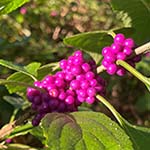
Beautyberry
Beautyberry (Callicarpa americana) – Beautyberry is a low-maintenance shrub found in USDA Hardiness Zones 7 through 11. Beautyberry's clusters of brilliantly purple fruits are sometimes harvested to make jams and jellies. To be sure, they need a lot of sugar, but the color is worth it! And if you decide not to pick them the birds will happily do the job for you.
Blueberry (Vaccinium spp.) – Did you know blueberries were native to Florida? Rabbiteye (Vaccinium virgatum) and southern highbush (hybrids of V. darrowii, V. virgatum, and V. corymbosum) blueberries are the best choices for our hot and humid climate. Blueberries are not low maintenance, though. If you do decide to add blueberries to your landscape choose at least two different varieties. Plant them close together for cross-pollination or fruit will not set.
Cabbage palm (Sabal palmetto) – The cabbage palm, or sabal palm, is Florida's state tree. It is native to all areas of the state and extends up the coast to South Carolina. The bud of the tree—sometimes called the "heart"—is edible. It has a cabbage-like flavor, thus the common name. Unfortunately, removing the bud kills the palm. We don't suggest you take down an entire tree for a meal. But if you have a cabbage palm growing out of place, don't miss the opportunity. Making a dish of swamp cabbage can kill two birds with one stone.
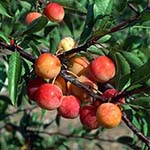
Chickasaw plum
Chickasaw and Flatwoods Plum (Prunus angustifolia and P. umbellata) – Chickasaw and flatwoods plum trees flower in early spring and then produce small red, yellow, or purple plums. The fruits range from very tart to sweet. This fruit is eaten fresh or turned into tasty jelly, but they're also a favorite of local wildlife. Chickasaw plum is hardy to USDA zones 5-9. The range of flatwoods plum is a little narrower: zones 8A through 9B.
Florida Betony (Stachys floridana) – Florida betony is considered a landscape weed. We think it's one worth pulling, but for another reason: the tubers are edible. The long, lobed shape reminded settlers of a rattlesnake's tail. This is where betony picked up its older common name, "rattlesnake weed." Betony is also called "wild artichoke," though it is not related. Instead, tubers are eaten fresh and add a crisp texture to a Florida-native salad.
Maypop (Passiflora incarnata) – Wild passionflower, also called maypop, is a native Florida fruit. These vines grow rapidly in USDA Hardiness Zones 7B through 11. The fruit and its skin are edible, though less tasty than cultivated passionflower. They can be eaten raw or cooked. It also makes a good jam, syrup, and flavoring for beverages. Some gardeners mistake maypop for an invasive species because of their tropical appearance and aggressive growth rate. It is native, but heavy pruning may be necessary.
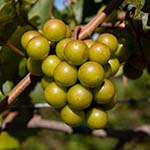
Muscadine grapes
Muscadine Grape (Vitis rotundifolia) – This tasty vine is native to our state and other areas of the Southeast. Sometimes called scuppernongs, muscadine grapes are very popular. Homeowners in particular appreciate their high degree of tolerance to pests and diseases. Wild muscadine vines can be either male or female. If you don't have the room for multiple vines, opt for a self-fertile variety. You can learn more about variety selection and cultivation in our feature article on muscadine grapes.
Pecan (Carya illinoensis) – Like blueberries, pecan is a crop so well-known we sometimes forget it's also native to Florida. Native Americans used pecans as a food source for thousands of years before the arrival of Europeans. In Florida, pecan trees can be found in all regions between Pensacola and Miami, although many of the pecans grown in the south offer lower yields. For more on adding pecans as a crop in your landscape, consult our feature article on pecans.
Persimmon (Diospyros virginiana) – While less popular than the Japanese persimmon, Florida's native persimmon is plenty tasty. If you've never had a native persimmon the flavor is good but difficult to describe. The ripe flesh is thick and jelly-like, best eaten with a spoon. In fact, you don't see native persimmons in the grocery store because they are so delicate. Fruits are too soft to ship once they're ripe, and under-ripe fruit are hard and bitter. D. virginiana is found in USDA Hardiness Zones 4B through 9B. Be sure to purchase a female tree — the males don't produce fruit.
Pickerelweed (Pontederia cordata) – A close relative of the dreaded water hyacinth, pickerelweed is native to USDA Hardiness Zones 3B through 10. It grows in wet areas and along pond and lake banks. Young, unrolling leaves can be eaten fresh or cooked in the spring. In the fall the starchy seeds begin to ripen. They can be ground into flour, boiled like rice, added to nut mixtures, or eaten raw. Indigenous peoples of Maine and New Brunswick used infusions of pickerelweed as a contraceptive, but there is no evidence that the plant serves this purpose and it is not listed as toxic.
Red Maple (Acer rubrum) – Florida's native red maple is a close relative of the famous, syrup-producing sugar maple (Acer saccharum). Though it won't make a sweet syrup, Acer rubrum sap can be made into a sweet drink. The seedlings and leaves of red maple are off limits, though. They are known to kill livestock and other animals. Whether or not you decide to add this tree to your beverage list, red maple makes a showstopping addition to any landscape in USDA Hardiness Zones 4A through 9B.

Red mullbery. Photo: David Stephens, Bugwood.org
Red Mulberry (Morus rubra) – Peoples of North America have enjoyed native red mulberry for centuries. On expedition in the mid-1500s, De Soto observed Muskogee Indians eating dried mulberry fruits. The Iroquoian, Cherokee, Timucuan, and Seminole peoples also included the berries in their cooking and used the tree's wood as well. Today we appreciate mulberry trees in the landscape because they require very little maintenance, irrigation, or fertilizing. Red mulberry grows naturally in all areas of Florida, and up the eastern seaboard into Canada, too.
Sea Grape (Coccoloba uvifera) – Seagrape takes its common name from its coastal home and the clusters of red, grape-like fruits it produces. Though not true grapes, these fruits are edible and the taste is often compared to muscadine grapes. Like our native mangrove, seagrape is also a protected plant. You cannot destroy, damage, or pick shoreline seagrape without a permit. To enjoy this classic Florida fruit, add it to your home landscape, away from the waterfront. The natural range of seagrape is USDA Hardiness Zones 10A-11. It has been reported as far north as zone 9A, but is sensitive to frost and freeze.
Smilax (Smilax spp.) – Smilax is also called "wild asparagus," greenbriar, and bamboo vine. Gardeners battle with it in their yards but these aggressive vines are native to the entire state. The young vine tips are edible and resemble asparagus in flavor and form. The underground tuber is useful, too, as a thickening agent and has been used as a source of starch. Finally, Smilax officinalis, S. papyracea, and S. medica are sources of the drink sarsaparilla. Be careful though, sarsaparilla should not be confused with sassafras, a drink with potentially dangerous side effects.
Yaupon Holly (Ilex vomitoria) – Don't be deterred by the alarming scientific name; yaupon holly makes an excellent tea. It is also an extremely hardy native shrub, popular in landscapes from zones 7A-9B. True, it is not technically edible, but this plant boasts the highest caffeine level in North America. Maybe it's our caffeine craving speaking, but we believe yaupon deserves a place on this list of edible natives. You can learn more about planting directions, tea-making instructions, and how this holly got its name in our feature article on yaupon holly.
Edibles to Consume with Caution
The following species are considered edible but require careful preparation or identification.
Elderberry (Sambucus nigra ssp. Canadensis) – Elderberry flowers and fruit have been prized around the world since prehistoric times. Pies, jellies, syrups, wines, spirits, teas, and dyes are just a few products you'll find packed with elderberry goodness. And of course the local wildlife have always enjoyed this abundant food resource. Elderberry plants do contain toxins, however, cyanogenic glycosides (CNGs). Only the ripe berries and fresh flowers are safe to eat. We suggest cooking them first, too, because they contain trace amounts of CNGs.
Oak (Quercus spp.) – Acorns are one of Florida's most abundant crops, but we generally leave the harvest to the squirrels and other wildlife. That's really a shame because acorns are edible once roasted. Acorns of white oaks (Q. muehlenbergii, Q. virginiana, Q. lyrate, and Q. stellata) are better tasting than those of red oaks because they have fewer tannins. There is some evidence that oak plant material can be toxic at high doses. Most cases were of livestock suffering from grazing on oak leaves or acorns. Just the same, we suggest moderation and to keep acorns away from children.
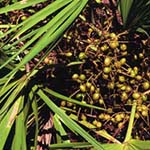
Saw palmetto. Photo: James H. Miller & Ted Bodner, Southern Weed Science Society, Bugwood.org
Saw Palmetto (Serenoa repens) – Saw palmetto berries are an important food source for many mammals and birds. Recently the fruits have received attention as a treatment for prostate cancer, despite statements from the American Cancer Society that say there is no evidence of this. Because of increasing interest in the berries, a permit is now required to protect and preserve these plants. Anyone harvesting the berries must acquire a "Native Plant Harvesting Permit." Permits are issued through theFlorida Department of Agriculture and Consumer Services (FDACS) Division of Plant Industry (DPI). Humans can consume saw palmetto berries, but be warned — severe fines follow collection without a permit, even on private property.
Species We Do Not Recommend
The following species we do not recommend consuming. We include them here only because they have been considered edible in the past. Our hope is to help would-be foragers understand why they are no longer considered safe.
Butterfly Weed (Asclepias tuberosa) – Different Asclepias species are listed as a source of poison, food, and medicine in the historical record. Tribes of the southeast reportedly boiled it and ate it as a vegetable. Yes, A. tuberosa is considered only minimally toxic, but its plant tissues still contain cardenolides, toxic to the cardiovascular system. Other Asclepias species contain lethal doses of cardenolides and neurotoxins as well. Although humans once considered butterfly weed edible, we would caution you to avoid it.
Coontie (Zamia integrifolia) – Coontie is the only cycad native to North America. It is found in USDA Hardiness Zones 8B – 11. Coontie is best known as the preferred food source for larvae of the rare Atala butterfly. Humans once considered it an important food source, too. Members of the Timucuan and Calusa ground up the root to create a starchy flour for cooking. Early Florida settlers followed suit up until World War I. Like most cycads, coontie is toxic. It is dangerous to consume unless prepared properly. If you decide to consume coontie flour, receive proper training and do so only with extreme caution.
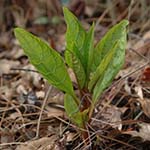
Pokeweed. Photo: Wendy VanDyk Evans, Bugwood.org
Pokeweed (Phytolacca americana) – All parts of the pokeweed plant contains saponins and oxalates. These toxins can be minimized in young shoots if they are properly cooked however we do not advise it. According to Toxic Plants of North America (2012), "In spite of its long-standing use as a potherb, Phytolacca should be used with some caution because incidents of serious illness occur even with careful preparation according to methods reputed to ensure edibility." We include pokeweed on this list, but not because we think you should eat it. Rather, our native pokeweed is so well-known that we feel it's worth the warning.
For help identifying any plant, please contact the experts at your county Extension office.

